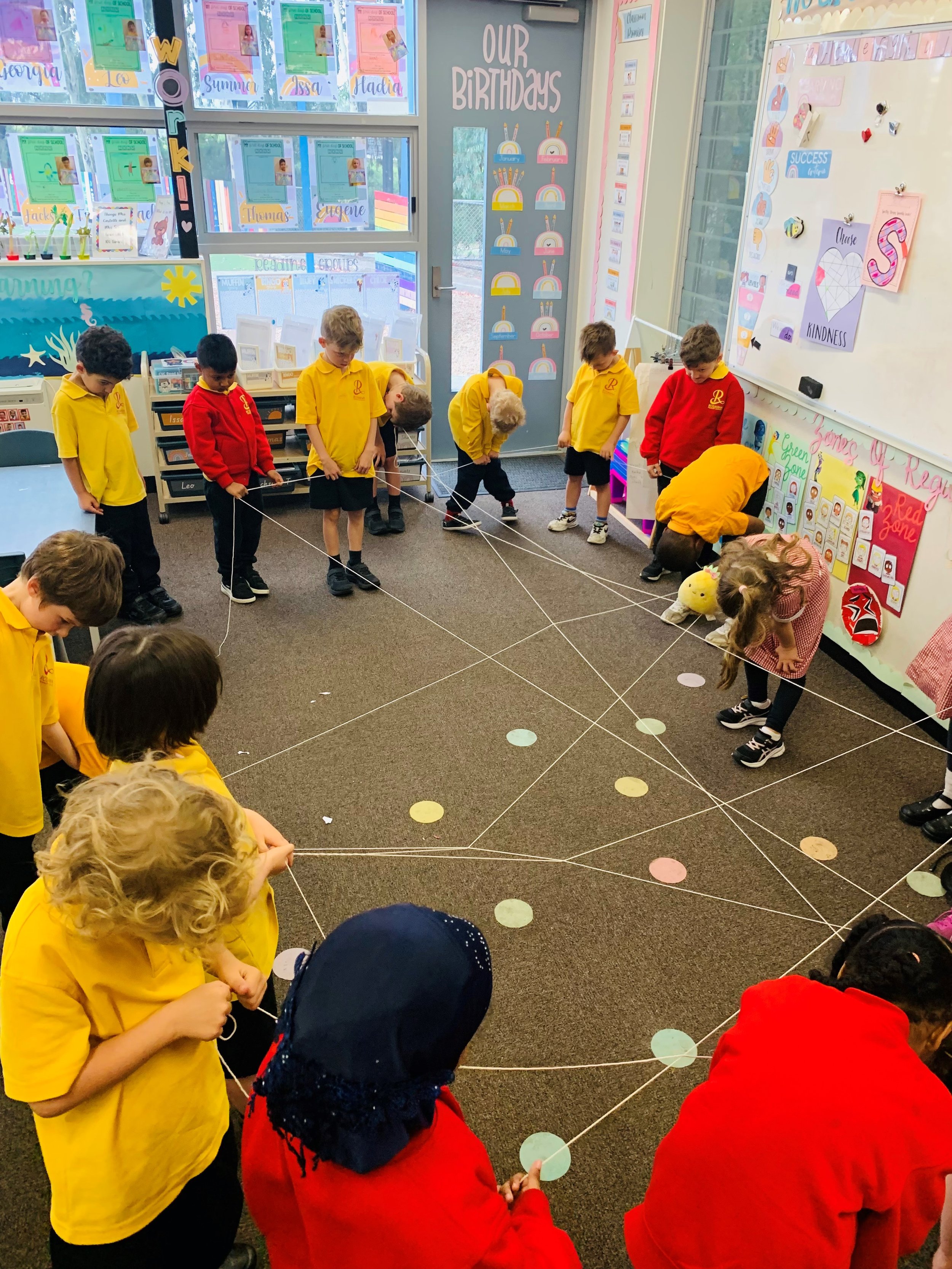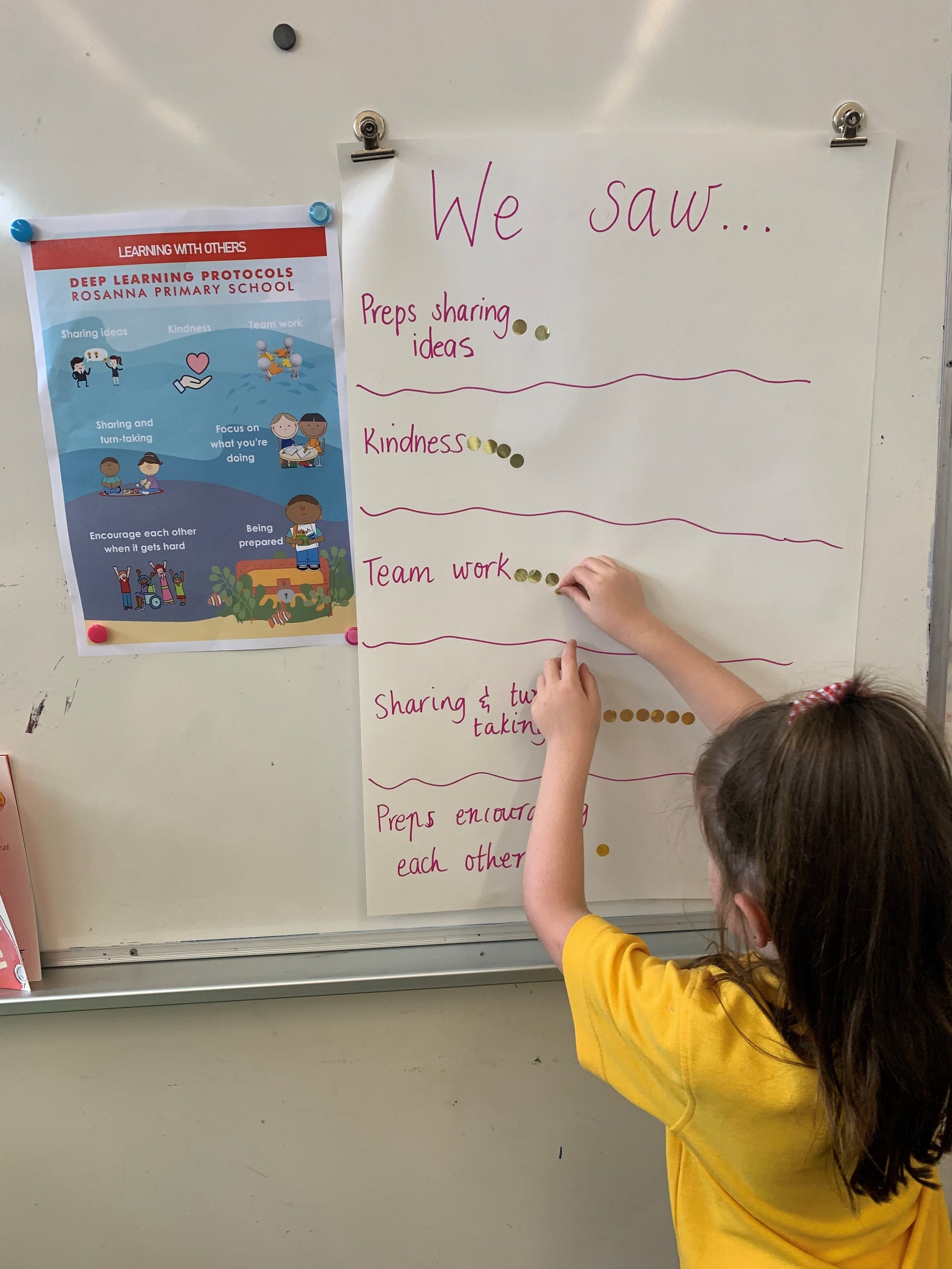Deep Learning Protocols
This article was first published in ReConnectEd.
By Sophie Cartelli
The development of the Rosanna Primary School ‘Deep Learning Protocol's in 2019 was a chance for students to be involved in establishing shared understandings of what learning should look like for the whole school. Developed by students, it provides an agreed language and focus for shaping and discussing learning in the classroom. Since implementing these, we have created spaces for everyone’s voices to continuously rework and reshape them, based on our needs. A great example of this is involving our junior students to help make our Deep Learning Protocols Prep-2 friendly.
To begin this process, the 2021 Junior School Council (JSC) students (ranging from Years 2 – 6) were consulted about which protocols could be adapted to suit our Prep – Grade 2 students and be easily integrated into the classrooms. Students developed a timeline of when each protocol should be introduced (for example, some of the protocols could be tied into our Start Up program and introduced in Term 1). Once these timelines were established, work began in the Prep classrooms to explore student voice. Prep teachers provided a range of opportunities for the Prep students to make decisions about their learning. This proved a way to explicitly show their ability to use student voice. This continued throughout remote learning, where the Prep teachers consulted students about the learning they enjoyed and what they wanted to do each week. Once we were back in the classroom and face to face again, the Prep students engaged in a range of workshops to unpack each of the Deep Learning Protocols, working in groups to determine what they believed ‘deep learning’ looked like for each protocol. Their ideas and responses were in junior student-friendly language and bundled into central themes and formed the revised Prep – 2 Deep Learning Protocols. The next step for the Preps was to develop visuals to support each of the learning dispositions under each Protocol. The goal was for this cohort of Prep students to be the experts and teach the following year’s Preps about effective deep learning.
Whilst COVID was a challenging time and caused a delay in completing this process, I continued to work with the Prep students as they moved into Grade 1 in 2022. It was important to show them how valued and important their voices are, and how they all have the capacity to act and make effective change. I used all this information to develop the visual Deep Learning Protocols in draft form. The JSC team then met with the now Grade 1 students and together, they collectively finalised the Protocols and offered suggested changes and amendments.
The Grade 1s who were involved in this process since 2021, with support of the JSC, planned workshops and delivered these in each of the Prep, 1 and 2 classes to further explore the revised P-2 Protocols. They have also supported the Prep teachers with how to introduce the first protocol, to get a head start on developing the Preps’ understanding of what it means to be an effective deep learner. At the end of last year, some students from the JSC attended a staff meeting to introduce the finalised Prep-2 Deep Learning Protocols and used one of the student-developed and led activities with the staff. It was a very empowering experience for the students, the experts of deep learning, to inform teachers about the purpose of the protocols and how to engage with them.
I incorporated all this information into our 2023 ‘Start Up’ program for the Prep-2 teachers with a suggested plan on how to introduce each of the Protocols, along with student-developed activity ideas.
This year, the 2023 Prep classes have been introduced to student voice and what it means in the context of their learning. They stood in a circle and took turns sharing what they love about learning, how they like to learn and what they’d like to learn more about. As each student shared, they passed a ball of string around and once everyone contributed, they were able to see a web yhat was a visual representation of how interconnected their ideas are and how they are all part of the learning journey.
The Prep classes have been introduced to the Deep Learning Protocols, which, as a starting point, are being used as a basis for their development play. For one session, their goal was to focus on the protocol of ‘Learning with Others’. They used sticker dots to record each time they saw or heard their examples of their peers demonstrating the dispositions of the protocol.
The 2021 Preps who began this incredible journey, demonstrated outstanding agency in the way they shaped and developed our values for learning at Rosanna Primary School. Further to this, as the ones who enter classrooms and deliver workshops that they’ve co-created with their peers, it is significantly empowering for our junior students as they are witnessing and experiencing firsthand, just how valued their voices are. This year they are in Grade 2 and have paved the way for student voice and agency in the younger years for the students who have come after them and will continue to come over the years.
Teacher Reflection
In the initial shaping of the Deep Learning Protocol's, students spoke of learning being like swimming. Some stay at the edges, chasing the wash of the waves up and down the beach. One student explained, “in the shallows, you are just dipping your toes into the rock pools”. As learners become more adventurous, they head out into the waves and learn to put their heads under water. Then, there are those who wear suits and explore the depths of the seas. One student emphasised, “You see! That is where the real treasure is!” Another continued, “there is a sense of accomplishment at the bottom, when you are exploring, when you discover the treasure!” Students more clearly described learning as shallow, underwater and deep. The Learning Protocol's were rephrased as ‘Deep Learning Protocols’.
When I met with the JSC students in 2021, I asked them what they thought about how to introduce the Protocol's to Prep students. It was their advice to remove the levelled reflections so that the Junior students could focus solely on doing their ‘deepest learning’, and remove the abstract idea of multi-levels of learning, for now. Instead, they recommended that the levels be introduced from grade 3/4 where they will have developed a strong understanding of self-evaluating their own deep learning. Next, we discussed whether all 9 of the protocol's should be introduced to junior students. The JSC went through each and came to the conclusion to focus on only 8 out of the 9 at the junior level, choosing to leave out the protocol focusing on metacognition: ‘Thinking About Thinking’. When I asked the JSC for their reasoning, they explained that it is such an abstract concept for the young students and they don’t want to risk them disengaging from the protocol's. This is where they emphasised the importance of the Protocols being accessible for all students. From the perspective of the Prep teachers, we have seen how easily our students have engaged with the language of the Deep Learning Protocol's. The Protocols have been so easy to incorporate into any learning activity we do and we have just started using them as a way for the Preps to reflect on their learning throughout a lesson. I’ve had some Preps even question whether they think they did their deepest learning after a task, which led to a rich discussion about how they can improve next time.
I spoke to the Grade 1/2 teachers who used the original Deep Learning Protocol's last year. They reported that the initial ones were way too wordy, and although they had them displayed in the classroom and tried to incorporate them into teaching and learning, it was simply too much information and not visual enough. Since incorporating the revised P-2 protocol's, they reported how much they are using them and referring to them daily. The 1/2 students even used the protocol's to set learning goals for the term, including how they will achieve their goals. The biggest difference is that there are very minimal, short and sharp words/phrases under each protocol, accompanied by a clear visual, making them so much more accessible for all their students.
Considering all of this, the junior school teachers have observed a shift in their students being able to self-reflect on their learning and identify what they need to do to achieve a goal or do their ‘deepest learning’. The language is consistent across the school so students are familiar with it, are using the protocol's daily and are engaging so positively, which has had a positive impact on their ability to be independent learners.
Sophie Cartelli
Sophie began working at Rosanna Primary School in 2015 in Grades 5/6 with a keen interest and passion for student voice and agency, and student-led learning. In 2016, she undertook the leadership of our Junior School Council group with the goal of shifting it from solely a fundraising body to making real change within the school in the context of student voice and agency.
Contact:




